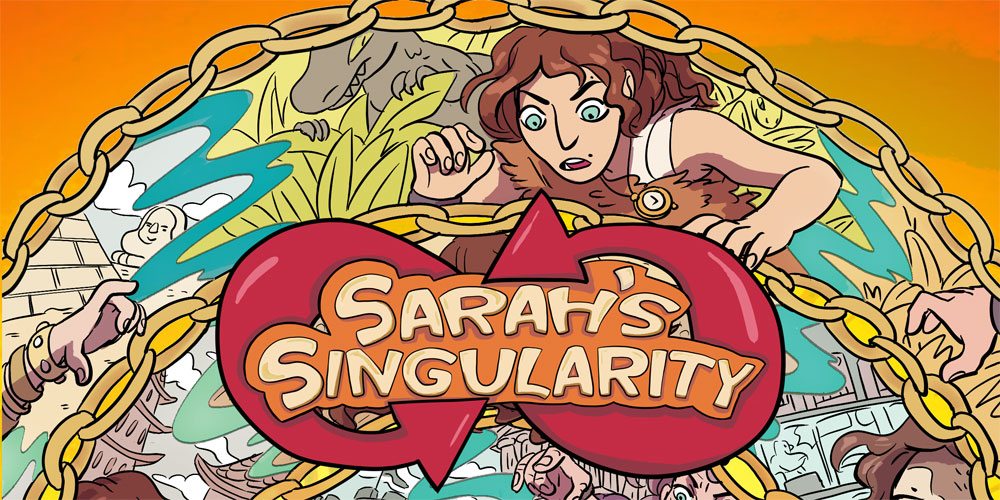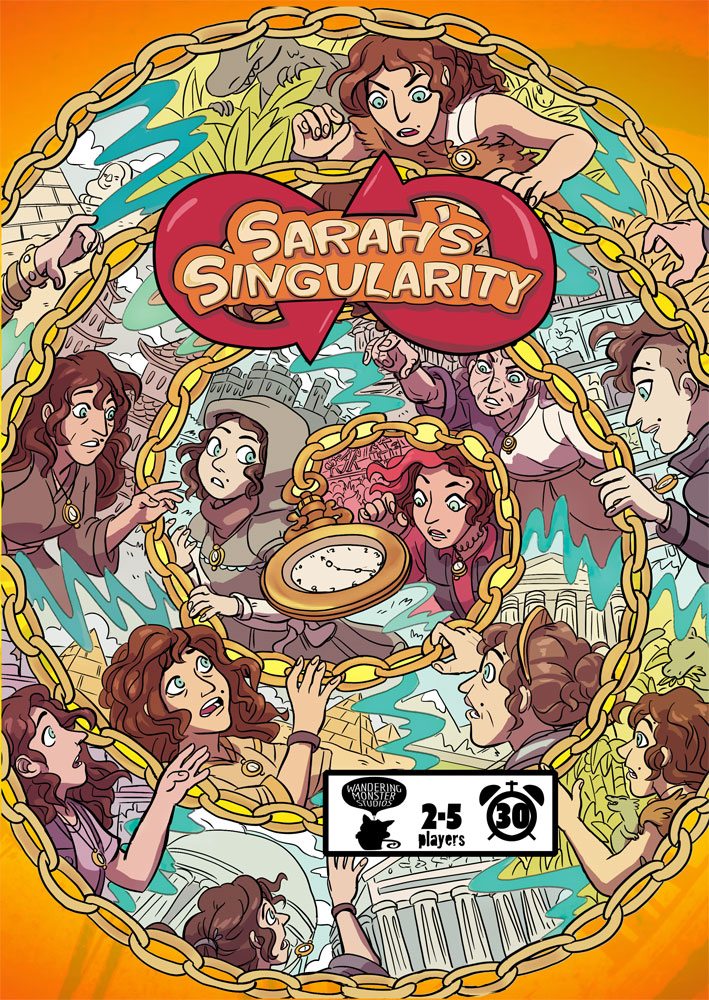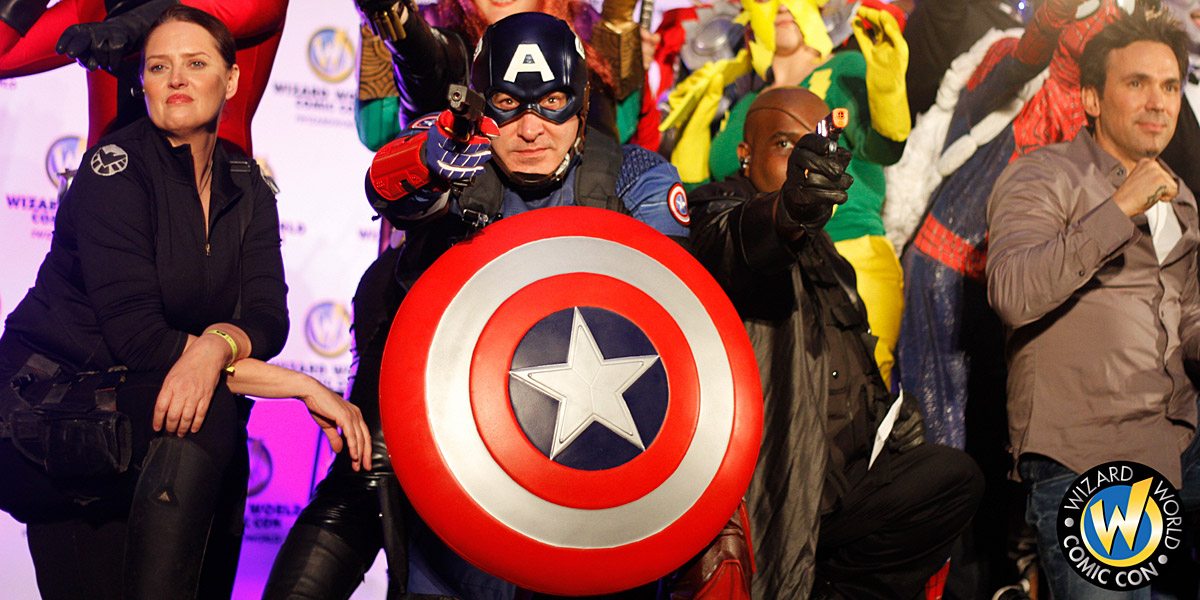Sarah is a time traveler, passing through different eons and stranding her various companions. Fortunately, there are other versions of Sarah who are out to fix things, returning companions to their home timelines and accomplishing missions. Can you make the most of Sarah’s Singularity?
What Is Sarah’s Singularity?
Sarah’s Singularity is a time-travel game for 2 to 6 players, ages 8 and up, and takes about 30 minutes to play. It’s currently seeking funding on Kickstarter, with a pledge level of $24 for a copy of the game or $29 for the deluxe “Prime” edition. I think the 8+ age rating seems about appropriate: the theme and the gameplay complexity should both be okay for middle-grade kids and up.
New to Kickstarter? Check out our crowdfunding primer, and visit our Kickstarter curated page for more projects we love.
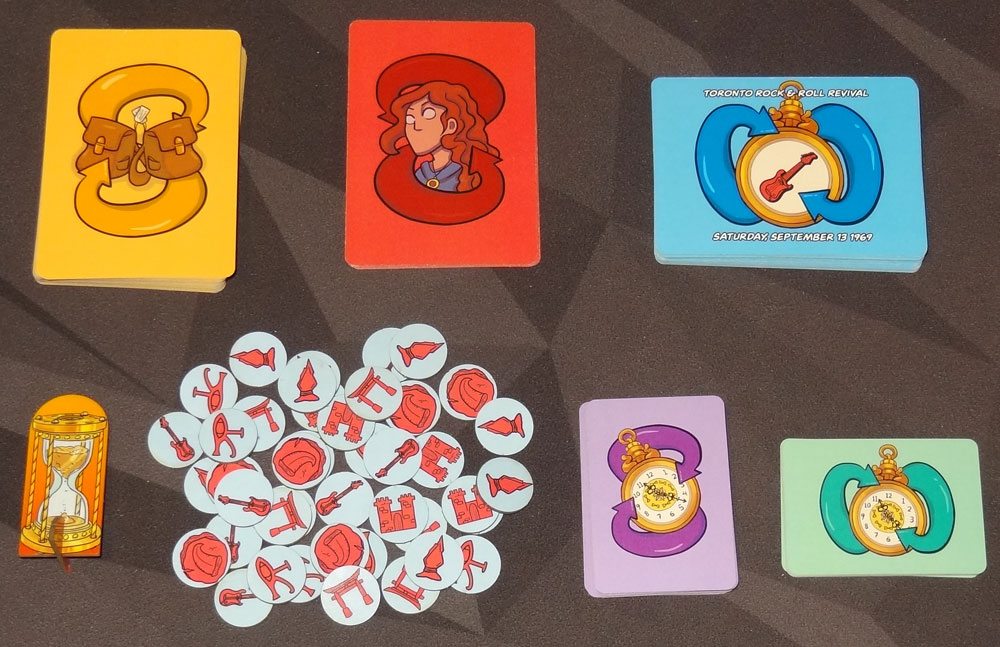
Sarah’s Singularity Components
Note: My review is based on a prototype, so components are not final and do not reflect final production quality. My copy does not have the 7th time zone—2012 Comic-Con—and it did not have a Sarah Prime card. Stretch goals and deluxe editions may also introduce additional components so the final component count may differ.
- 48 Companion cards
- 49 Mission cards (7 per time zone)
- 49 Zone tokens (7 per time zone)
- 42 Selector cards (7 per player)
- 12 Personal Objective cards
- 10 Sarah cards
- 1 Sarah Prime card
- 1 Chronologist token
The deluxe edition will include wooden tokens for the chronologist token, Sarah Prime, and players.
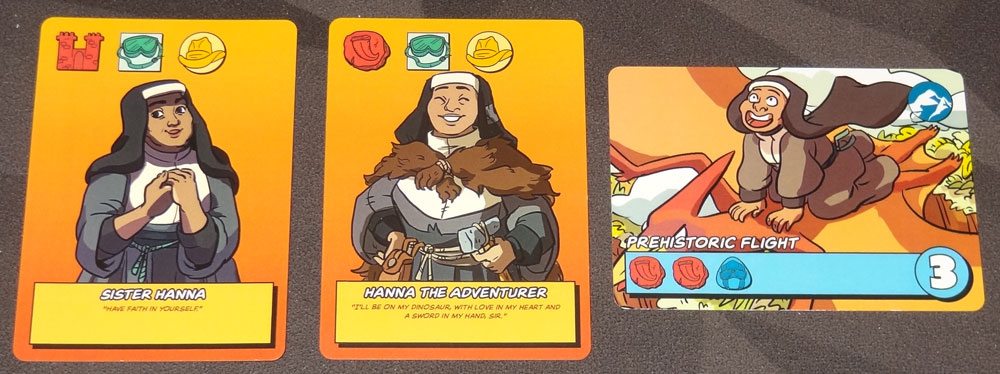
The illustrations, by Carey Pietsch, are a lot of fun and look like something from a comic book. There are a lot of fun connections—various companions show up in the mission card illustrations. There are also some connections between some of the companions, like Sister Hanna, a nun from the Forest of Dean in 1138 AD, who looks a lot like Hanna the Adventurer, who makes her home in Southern Pangea in the year 86,997,986 BCE. The mission cards also have a lot of fun connections to each other, and a lot of time-travel humor in them.
The game is primarily cards and a few tokens—for the most part, everything is fairly easy to read. We did have one complaint that the pilot icon (blue hat and goggles) and the researcher icon (green lab goggles) were a little too easy to get confused with each other, but generally the iconography on the cards is pretty easy to read.
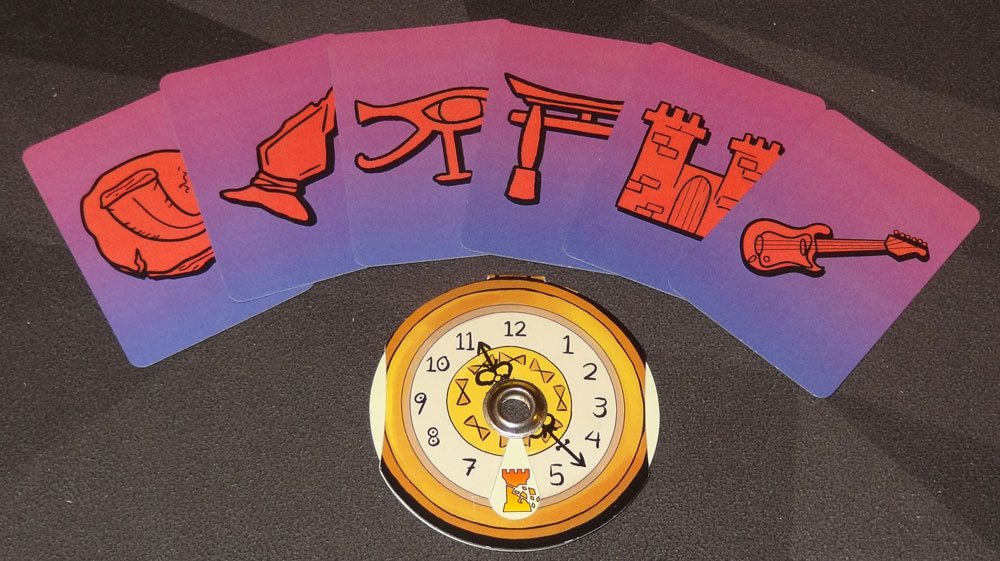
The selector cards, which players use to select which time zone they’re traveling to, may be replaced by a selector dial if a stretch goal is reached. You can see a sample of the selector dial here, which I used as a Sarah Prime token, though the finished version would be full-thickness punchboard instead of cardstock.
How to Play Sarah’s Singularity
The Goal
The goal of the game is to score the most points in seven rounds by rescuing stranded companions and fulfilling missions.

Setup
Separate the Mission cards into different time zones according to their backs, and choose a number of time zones equal to the number of players plus one. Shuffle each time zone separately, and then arrange them on the table in chronological order, and then reveal the top card of each time zone below the deck. Place the corresponding zone tokens next to each mission deck.
Sort through the companion cards, selector cards, and personal objective cards to remove any that belong to time zones that are set aside. Shuffle the remaining companion cards to form a single deck. Deal 7 companion cards face-up to form the Prime Row, spreading them out so the time zone icon is visible on each card. Place the Sarah Prime token on the right-most card. Deal one companion card face-up below each mission.

Give each player a randomly dealt Sarah card, a set of selector cards, 3 companion cards, and 2 personal objective cards. Each player selects a personal objective and returns the other to the bottom of the deck. Give the chronologist token to a random player.
Gameplay
Each round, Sarah Prime will travel to a time zone and drop off a companion there. Then, the players will simultaneously decide which time zone to travel to, potentially trigger paradoxes, and then take actions in chronological order.
Sarah Prime
Look at the time zone of the right-most companion card, and place it and Sarah Prime below the corresponding mission card. This is the time zone Sarah is visiting this round.
Choose Time Zones
Every player secretly chooses a time zone to travel to using their selector cards, and then once everyone has chosen, they are all revealed simultaneously.
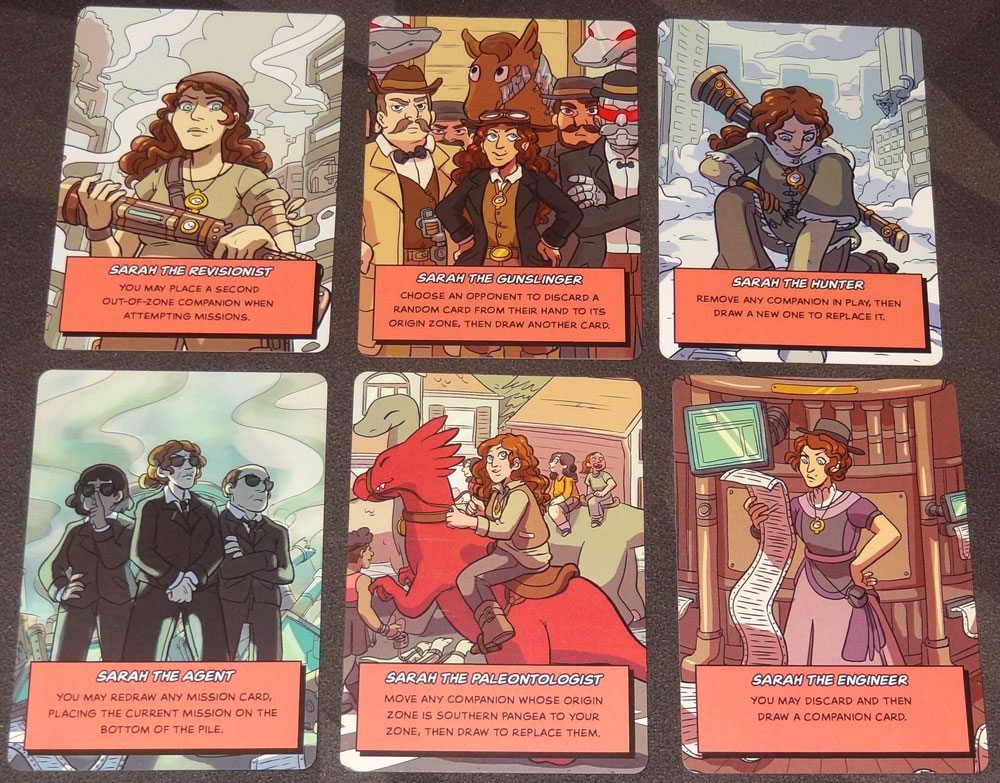
Resolve Paradoxes
If two or more Sarahs end up at the same time zone (including Sarah Prime), there’s a paradox! Shuffle all affected Sarahs (except Sarah Prime) back into the deck, and then deal out new Sarah cards for affected players.
Take Actions
Play resolves in chronological order. If there’s more than one player at the same time zone, the chronologist gets to decide the turn order for that time zone. Then, give the chronologist token to the player who will go last in that time zone.

On your turn, you may take any of these actions in any order, but you may only do each one once:
- Rescue a companion: Pick up any companion from your current time zone. If it came from a different time zone, then it was a “lost” companion, and you get a zone token from your current time zone as a reward.
- Drop off a companion: Play any companion from your hand to your current time zone. You may play any number of companions if they match the current time zone, or only one companion if it doesn’t match.
- Use your Sarah power: Each Sarah card has a special ability, which you may use once on your turn.
- Solve a Mission: Each mission has some combination of time zone icons (matching its current time zone) and skill icons. If the total number of icons on the companion cards at that time zone meet or exceed the mission requirements, you can solve the mission. You may discard one matching time zone token as a wild icon (for zone or skill icons) toward completing a mission. Take the mission card and place it face-up in your scoring pile, then discard all companions in that time zone.
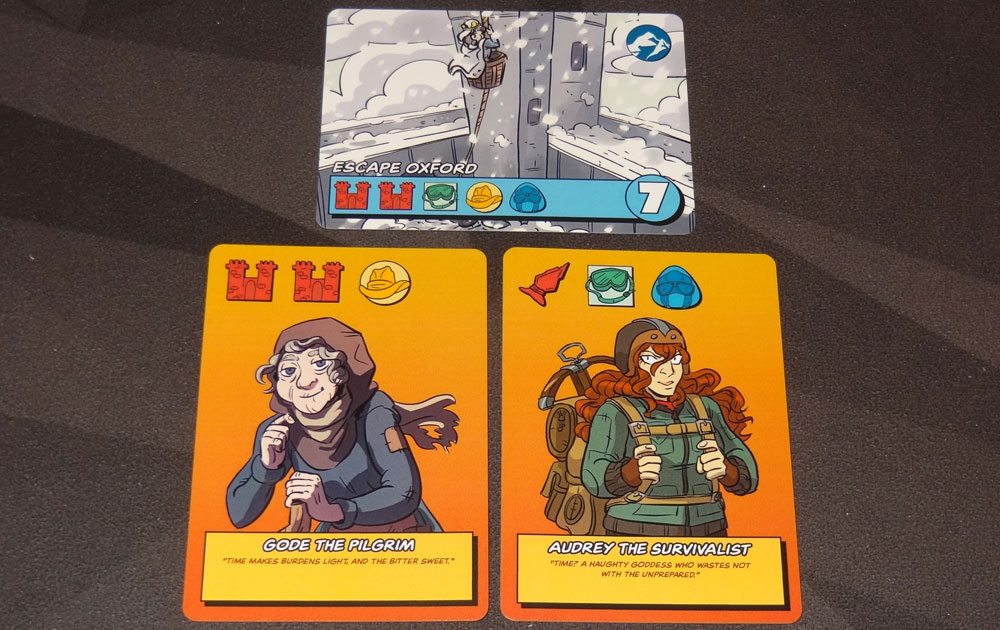
At the end of your turn, draw or discard companions until you have at least 3 companions and no more than 5 companions. If you solved a mission, draw a new mission and a new companion for that time zone. Turn passes to the next player.
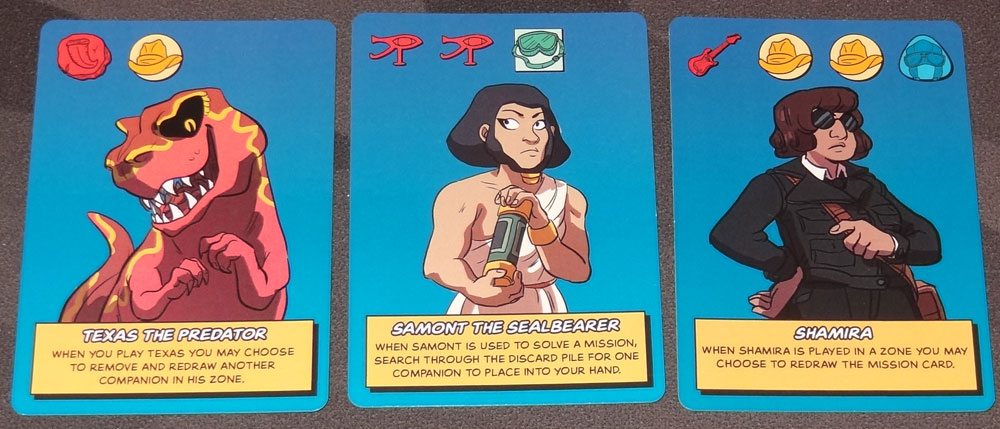
Game End
The game ends either at the end of round 7 (when there are no more cards in the prime row to start the next round) or when the last mission card from any time zone is completed.
Scoring
You score points for the following:
- Completed missions: Each mission has a point value on it.
- Time zone tokens: 1 point per unspent token.
- Mission sets: Some missions have mission icons on them—fun, adventure, science, and profit. Whoever has the most of each icon on their completed missions scores 4 points. If two players tie for a category, nobody scores bonus points for that category.
- Personal objectives: Your personal objectives give you additional points if you achieve them.
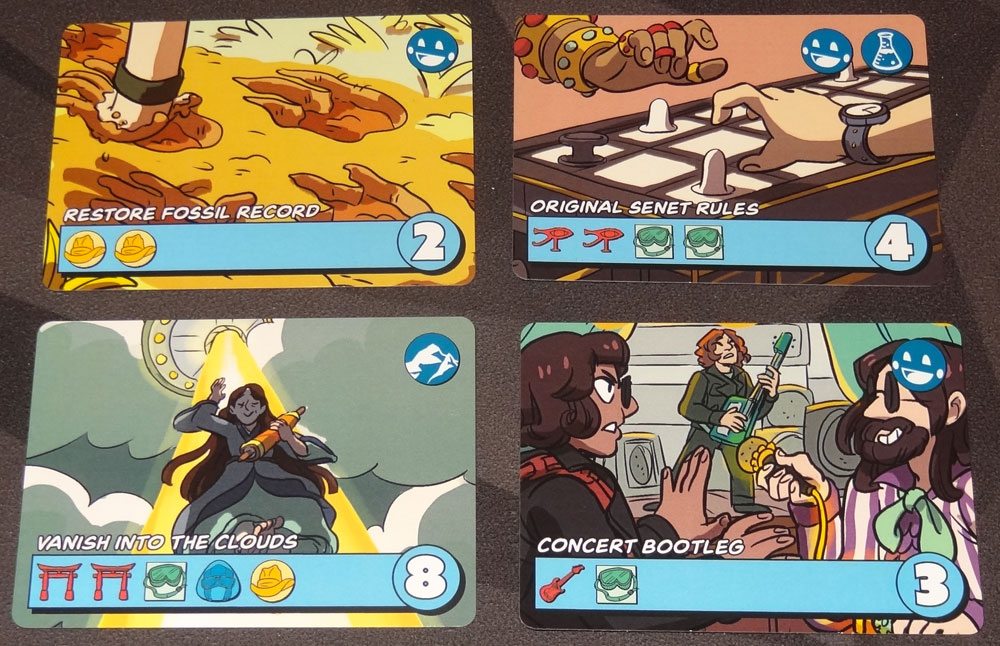
The highest score wins, and becomes the new Sarah Prime!
Why You Should Play Sarah’s Singularity
I’m a sucker for time travel stories (just take a look at any of these Stack Overflow Columns). So I also love trying out time travel games, to see how they handle time travel concepts and what sort of story it is. In Sarah’s Singularity, I think a lot of the time travel aspect is in the theme and flavor of the game, though the time travel is kind of light as far as the game mechanics go. Let’s take a closer look.
Thematically, I love all the various companions and versions of Sarah. The illustrations, names of the missions, and the flavor text on the companions really work together to make it feel like there’s a larger story—that if you could just piece together all of the cards in the right order, you’d be able to read it like a comic book. You’ll wish that every Sarah had an entire back story explaining how she ended up in a particular time or with those skills. The time travel itself is fairly loose and hand-wavey—there’s no explanation given for how Sarah travels through time, and there don’t seem to be hard and fast rules about what you can and can’t do in the past.
The reason I say that most of the game mechanics aren’t heavily time-travel based is that most of the game could function the same way if they were just different locations rather than also different time periods. That’s not to say that it doesn’t work as time travel, but that it’s more of a thematic choice than one that feels completely integral to the gameplay.

The gameplay is fairly light and easy to pick up, not nearly as confusing as actual time travel. I like the simultaneous selection mechanic in many games—in general, it’s great to go where nobody else is going, because then nobody is interfering with your plans. But since there are only so many time zones to choose from, conflicts are common. The mechanic of shuffling your Sarah card back into the deck and drawing a new one when you trigger a paradox is one of the primary time-travel-based mechanics: something happened to your timeline and you may wind up with a different personality. If you want to swap out your Sarah card for some reason, you can choose to go to wherever Sarah Prime is that round, because that will guarantee a paradox for you even if nobody else chooses it.
Solving missions is a mix of strategy and luck: you may know at the start of the round whether you’ll have the right icons to complete a mission, but things can get messy. You might end up sharing a time zone, and losing that Sarah ability you were counting on. Somebody else might take the mission before you, giving you a new mission that you’re unprepared for. Some Sarahs and companions have the ability to manipulate companions in other locations—so even if you didn’t trigger a paradox, you may find that you’re short a few icons by the time it’s your turn. Picking up valuable companions (with lots of skills) can help prepare you for future missions, even if you’re unable to complete one this turn.
One issue I ran into, though, is that sometimes you can end up with a turn where you don’t get to do anything*. Since you can do your actions in any order, it’s possible to play a companion, complete a mission (thus discarding all the companions there and drawing a new mission and companion), and then rescue the new companion, thus leaving a new mission but no companions in place. For the next player at that location, they may find themselves unable to fulfill a mission, and on top of that there aren’t any new companions to pick up, either. Since the game is only seven rounds long, losing an entire turn without scoring is pretty harsh.
UPDATE: It turns out that the new mission and companion are not placed until the end of your turn, so you cannot pick up the new replacement companion. Hopefully the final rulebook will make it more clear, but my current understanding is that the zones get replenished at the end of each player’s turn, so there should always be at least one companion at your location when you start your turn.
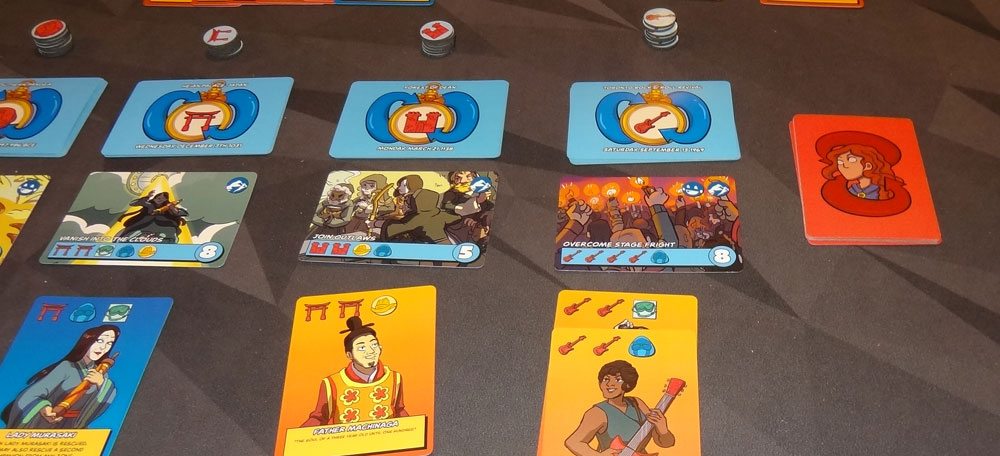
The chronologist token is meant to be sort of the consolation prize for that—when multiple people are at the same time zone, the chronologist gets to pick who goes first, and going last means that you get the token and will make the decision next time. However, if the next paradox involves other players and not you, then getting to choose who goes first doesn’t actually benefit you, so then getting the chronologist token doesn’t make up for your loss of the earlier turn. I’m not sure how best to address that complaint, though I think a fix would make for a more enjoyable experience for players even if they get stuck going last and are no longer able to complete a mission.
At any rate, I had fun playing the game even when I lost. It’s fun to imagine zipping through time, rescuing companions and then taking them with me on various missions. Once you get used to the play order, rounds go pretty quickly. It’s a fairly light game so it generally won’t tax your brain too much: if you like your time-travel games to be brain burners, this one might be too light for you, but if you’ve been lamenting that many time-travel games give you a headache, Sarah’s Singularity may be a good fit! For me, I’m still keeping Loop, Inc. and Legacy: Gears of Time around for the tough puzzle aspects, but I think Sarah’s Singularity will be an easier sell for my kids and more casual gamers.
For more information and to make a pledge, visit the Sarah’s Singularity Kickstarter page!
Click here to see all our tabletop game reviews.
Disclosure: GeekDad received a copy of this game for review purposes.
